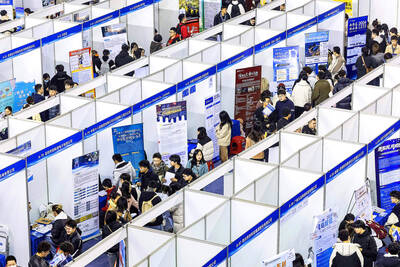The total revenue of the nation’s three major science parks dropped in the first 10 months of the year, hard hit by the European debt crisis and a sluggish US economy.
Science park sales fell 12.17 percent from a year earlier, according to figures released by the National Science Council on Saturday, a decline similar to the 12.14 percent year-on-year fall reported in previously released data for the first eight months of the year.
The Central Taiwan Science Park saw the biggest drop in revenues, with sales falling 20.97 percent to NT$246.26 billion (US$8.15 billion).
The Hsinchu Science Park’s revenues fell 13.42 percent to NT$843.97 billion, while Southern Taiwan Science Park sales declined 4.21 percent to NT$477.22 billion.
All of the parks attributed the poor results to the lingering debt crisis in Europe and the slow recovery of the US economy.
Hsinchu Science Park deputy director-general Tu Chi-hsiang (杜啟祥), the Hsinchu park’s, attributed the sales drop-off in the park to the nature of the products made there.
Most manufacturers in the park are in the information communications technology sectors, whose products include expensive computers and game consoles, he said. Customers are likely to put off purchases of these products when they do not have extra money at their disposal, he said.
The Central Taiwan Science Park was hurt by a sales slump in electronic products, exchange rate volatility and the debt crisis, the park administration said. TFT-LCD and the integrated circuits sectors are the two major pillars of the park, accounting for 70 percent and 23 percent of the park’s total sales. During the 10-month period, the two sectors posted revenue declines of 21 percent and 31 percent respectively.
However, the central science park said other businesses saw strong revenue growth, with computer peripheral sales up 131 percent, biotechnology revenues up 66 percent and precision engineering sales up 55 percent.
The southern park was not only affected by the situations in Europe and the US, but also by lower demand from China, Hong Kong and Macau, sources said.
The park’s optoelectronics businesses, especially panel makers, were the most affected, and manufacturers made strategic cuts in production to prop up sales prices, the sources said.

Stephen Garrett, a 27-year-old graduate student, always thought he would study in China, but first the country’s restrictive COVID-19 policies made it nearly impossible and now he has other concerns. The cost is one deterrent, but Garrett is more worried about restrictions on academic freedom and the personal risk of being stranded in China. He is not alone. Only about 700 American students are studying at Chinese universities, down from a peak of nearly 25,000 a decade ago, while there are nearly 300,000 Chinese students at US schools. Some young Americans are discouraged from investing their time in China by what they see

Taiwan Transport and Storage Corp (TTS, 台灣通運倉儲) yesterday unveiled its first electric tractor unit — manufactured by Volvo Trucks — in a ceremony in Taipei, and said the unit would soon be used to transport cement produced by Taiwan Cement Corp (TCC, 台灣水泥). Both TTS and TCC belong to TCC International Holdings Ltd (台泥國際集團). With the electric tractor unit, the Taipei-based cement firm would become the first in Taiwan to use electric vehicles to transport construction materials. TTS chairman Koo Kung-yi (辜公怡), Volvo Trucks vice president of sales and marketing Johan Selven, TCC president Roman Cheng (程耀輝) and Taikoo Motors Group

MAJOR DROP: CEO Tim Cook, who is visiting Hanoi, pledged the firm was committed to Vietnam after its smartphone shipments declined 9.6% annually in the first quarter Apple Inc yesterday said it would increase spending on suppliers in Vietnam, a key production hub, as CEO Tim Cook arrived in the country for a two-day visit. The iPhone maker announced the news in a statement on its Web site, but gave no details of how much it would spend or where the money would go. Cook is expected to meet programmers, content creators and students during his visit, online newspaper VnExpress reported. The visit comes as US President Joe Biden’s administration seeks to ramp up Vietnam’s role in the global tech supply chain to reduce the US’ dependence on China. Images on

New apartments in Taiwan’s major cities are getting smaller, while old apartments are increasingly occupied by older people, many of whom live alone, government data showed. The phenomenon has to do with sharpening unaffordable property prices and an aging population, property brokers said. Apartments with one bedroom that are two years old or older have gained a noticeable presence in the nation’s six special municipalities as well as Hsinchu county and city in the past five years, Evertrust Rehouse Co (永慶房產集團) found, citing data from the government’s real-price transaction platform. In Taipei, apartments with one bedroom accounted for 19 percent of deals last